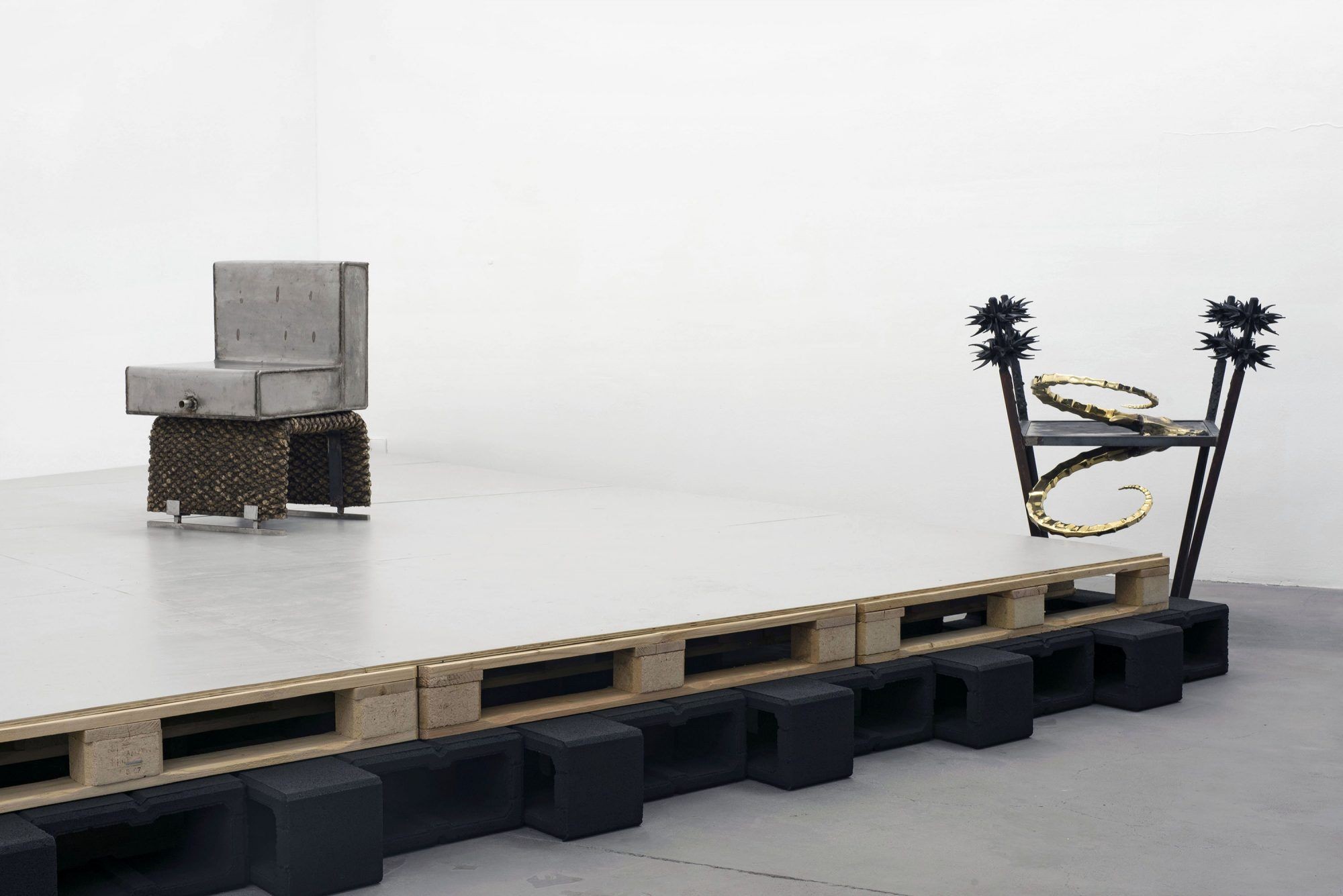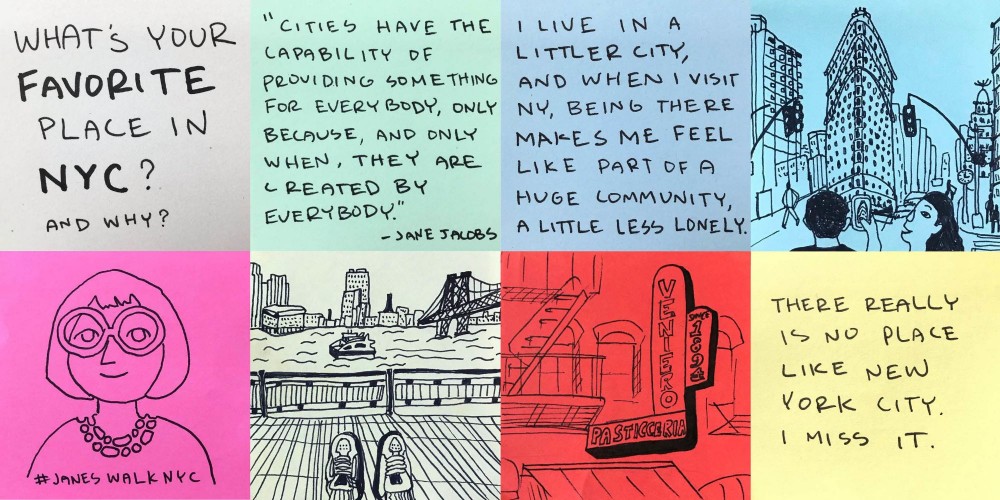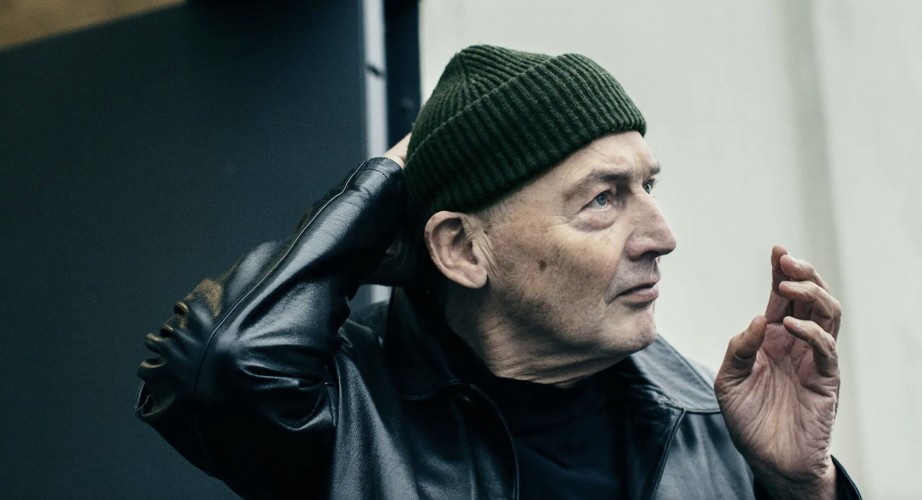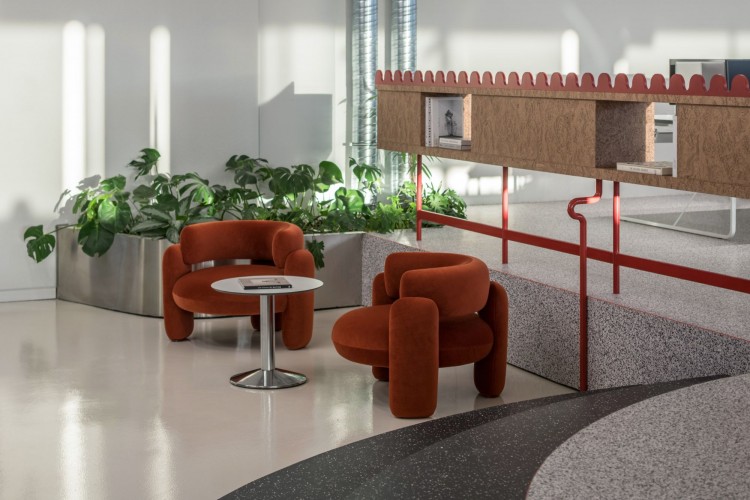"Cordyceps Gaud Adversary” του Dozie Kanu
DS.WRITER:
Σοφία Θρουβάλα
Κεντρική Εικόνα: Dozie Kanu, “Cordyceps Gaud Adversary”, Installationsansicht, Neuer Essener Kunstverein, © the artist and Philipp Kurzhals/Neuer Essener Kunstverein.
Ο Dozie Kanu είναι ένας Αμερικανός Νιγηριανής καταγωγής καλλιτέχνης, ο οποίος έχει σημειώσει σημαντική επιτυχία την τελευταία οκταετία. Χρησιμοποιώντας αντικείμενα-ευρήματα και ανασυστήνοντάς τα στο κοινό, δημιουργεί μια ιδιαίτερης αισθητικής γλυπτική η οποία ακροβατεί μεταξύ σταθερού και ασταθούς, χρηστικού και μη χρηστικού, ιστορικής αναφοράς και υποβόσκουσας ειρωνείας, ενώ, στα τελευταία έργα του, η καταγωγή του και η επαφή του με την κουλτούρα της επανάχρησης -κυρίως από μαύρους καλλιτέχνες- εμπλέκονται με πολιτικά ζητήματα, όπως τον νόμιμο φυλετικό ρατσισμό του Τέξας και την εμπειρία τού να ζεις όλη σου τη ζωή ως μετανάστης ακόμα κι αν γεννήθηκες σε Αμερικανικό έδαφος.
Τον περασμένο Νοέμβρη ολοκληρώθηκε η τελευταία του ατομική έκθεση με τίτλο "Cordyceps Gaud Adversary”, η οποία χαρακτηρίστηκε ως “προσωπική”, και πράγματι ήταν. Τρία έπιπλα-γλυπτά στέκονται σε μια αυτοσχέδια σκηνή, ως props κάποιας υποθετικής παράστασης που είτε έχει ήδη ολοκληρωθεί είτε αναμένεται να ξεκινήσει. Τα έπιπλα είναι παράξενα, και ακόμα κι αν είναι ευκόλως αναγνωρίσιμα σε σχέση με την ταυτότητα και την πιθανή λειτουργία τους, είναι κατασκευασμένα με τρόπο τέτοιο, ώστε να μοιάζουν άχρηστα. Από το καθένα στερείται το βασικό χαρακτηριστικό της λειτουργικότητάς του, καθιστώντας τα έργα αυτά δεσμευμένα σε μια απλή αναπαράσταση του εαυτού τους. Μια καρέκλα χωρίς κάθισμα και πλάτη, ένα τραπέζι με ανεστραμμένη επιφάνεια. Ένα μπιτόνι από λάδι α λα duchamp που γίνεται καρέκλα, φαντάζει ως το περισσότερο λειτουργικό έπιπλο και ταυτόχρονα το λιγότερο “κανονικό” από όλα (!). Τα σημαντικότερα όμως λέγονται “εκτός” σκηνής. Ακόμη δύο έπιπλα βρίσκονται όχι πάνω αλλά κοντά στην εξέδρα. Σε σχέση με τα υπόλοιπα, μοιάζουν να είναι περισσότερο περιγραφικά, καθώς και γεωγραφικά και χρονικά προσδιορισμένα, υπογράφοντας τον αυτοβιογραφικό χαρακτήρα της συγκεκριμένης έκθεσης, με έμφαση -θα λέγαμε- στην υποχρέωση του καλλιτέχνη να εξιστορήσει ένα κοινωνικό τραύμα.
.jpg)
Dozie Kanu, Chair [xvi], 2022, found steel oil container, found woven stool, steel, © the artist and Philipp Kurzhals/Neuer Essener Kunstverein.
Στα δεξιά της σκηνής βρίσκεται ένα μαύρο ατσάλινο τραπέζι με ενσωματωμένο ένα κεφάλι κριαριού από χυτό ορείχαλκο, με τίτλο “άτιτλο (merrill)”. Το βιβλικό σύμβολο του κριαριού είναι άρρηκτα συνδεδεμένο με το τοπίο του Τέξας, τόπο γέννησης του καλλιτέχνη, αλλά και με την αφρικανική κουλτούρα, ενώ επίσης ο τίτλος δίνει πολιτική έκταση στο έργο με άμεση και ξεκάθαρη αναφορά στην πρόσφατη σχετικά υπόθεση Merrill. Η Merrill Lynch είναι μια από τις μεγαλύτερες χρηματιστηριακές εταιρείες στη Wall Street, η οποία συμφώνησε να πληρώσει 160 εκατομμύρια δολάρια για να διευθετήσει μια αγωγή για φυλετικό ρατσισμό που έπληξε τα ομοσπονδιακά δικαστήρια για οκτώ χρόνια, στο Ανώτατο Δικαστήριο των Ηνωμένων Πολιτειών. Η πληρωμή της αγωγής, η οποία κατατέθηκε για λογαριασμό 700 μαύρων, προηγουμένως εργαζόμενων στη Merrill, ήταν το μεγαλύτερο ποσό που διανεμήθηκε ποτέ σε ενάγοντες σε μια αγωγή για φυλετικές διακρίσεις εναντίον Αμερικανού εργοδότη.
.jpg)
Dozie Kanu, untitled (Merrill), 2022, found brass casted rams head, acrylic polyurethane enamel paint, steel, anti-climb raptor spikes, epoxy sculpting clay, © the artist and Philipp Kurzhals/Neuer Essener Kunstverein.
Στα αριστερά της σκηνής, το έργο με με τίτλο “numb + dumb consciousness” μένει σχεδόν απαρατήρητο, κυρίως εξαιτίας της απόκλισής του από τα υπόλοιπα αντικείμενα στον χώρο. Αποτελεί μια γλαφυρή γλυπτική παρέμβαση που μοιάζει να αποδίδεται σε άλλον καλλιτέχνη, ωστόσο είναι άμεσα συνδεδεμένη με τα όσα εξιστορούνται στην έκθεση. Η διαφορά έγκειται κυρίως στην επιλογή του υλικού, αλλά και στον εντυπωσιακό χρωματισμό. Το διαφανές πλαστικό έργο είναι βαμμένο με ακρυλικό στα χρώματα της αμερικανικής σημαίας. Η φόρμα του παραπέμπει άμεσα στη μινιμαλιστική γλυπτική παράδοση, και σε διάσημα έργα των Ντόναλντ Τζαντ, Καρλ Αντρέ, Σολ Λεβίτ και Φρανκ Στέλλα της δεκαετίας του ’60. Το αντικείμενο είναι μια γλυπτική αναπαράσταση ενός “formicarium”, εργαστηριακού δοχείου που χρησιμοποιείται για την παρατήρηση των μυρμηγκιών, έμμεση αναφορά στις πληθυσμιακές μετακινήσεις προς την Αμερική με μοναδικό στόχο την εύρεση εργασίας, σε ένα σύστημα που προκαλεί βάρβαρες διακρίσεις και εκμετάλλευση της συνεχώς ανανεώσιμης εργατικής δύναμης.
Dozie Kanu “Cordyceps Gaud Adversary” at Neuer Essener Kunstverein, 2022. © Dozie Kanu / Kurzhals/Neuer Essener Kunstverein.
Η σκηνογραφία είναι εντυπωσιακή, γιατί κάνει την εγκατάσταση να είναι ταυτόχρονα ανοιχτή σε ερμηνείες αλλά και απολύτως δομημένη ως προς το νόημά της. Το σκηνικό στο Neuer Essener Kunstverein δείχνει την κλίση του Dozie Kanu για τη σκηνοθεσία, την οποία άρχισε να σπουδάζει αρχικά στη Νέα Υόρκη αλλά γρήγορα την αντικατέστησε με τη Γλυπτική και το design. Ο ίδιος ο τίτλος “Cordyceps Gaud Adversary” ακολουθεί με εντυπωσιακή συνέπεια τη σκηνογραφία και περιγράφει τα όσα η έκθεση διηγείται, πολύ καλύτερα από το δελτίο τύπου. O όρος Cordyceps (α’ σκέλος) χρησιμοποιείται για να ονομάσει ένα παρασιτικό είδος μύκητα, ο οποίος επιτίθεται στα μυρμήγκια και τα μετατρέπει σε ζόμπι. Το Gaud σημαίνει ευτελές στολίδι (κεντρικό -β- σκέλος) και το adversary (γ’ σκέλος) αφορά τις δικαστικές διαμάχες και το Αμερικανικό νομικό σύστημα υπεράσπισης. Ο έξυπνος αυτός τίτλος, αν και φαινομενικά ακατανόητος, δημιουργεί υποτίτλους και για τα τρία τμήματα-πράξεις της έκθεσης, η οποία δεν είναι παρά ένα αυτοβιογραφικά αποδοσμένο δριμύτατο “κατηγορώ” στις φυλετικές διακρίσεις στην Αμερική και κυρίως στο Τέξας.
Ο Kanu μεγάλωσε στο Τέξας ως παιδί Νιγηριανών γονιών, και ενώ όπως δηλώνει δεν θέλει να είναι “μαύρος καλλιτέχνης” αλλά “καλλιτέχνης”, το στοιχείο της καταγωγής γίνεται σταδιακά ένα με τη δουλειά του, μέσω της οποίας αφηγείται ιστορίες φυλετικής καταπίεσης.
.jpg)
Dozie Kanu, “Cordyceps Gaud Adversary”, Installationsansicht, Neuer Essener Kunstverein, © the artist and Philipp Kurzhals/Neuer Essener Kunstverein.
Μόλις το 2018 ταξίδεψε για πρώτη φορά στη Νιγηρία, όπου γνώρισε την αφρικανική χειροτεχνία, η οποία τον έκανε να αντιληφθεί πως η μινιμαλιστική αισθητική τού δυτικού κυρίως κόσμου, φόρμες που ο ίδιος προτιμούσε στην εικαστική πρακτική του, είναι εκ διαμέτρου αντίθετη από εκείνη της αφρικανικής και αυτό για τον Kanu σημαίνει κάτι! Το εξερεύνησε συνδυάζοντας αυτές τις τεχνικές που αποτελούν εξίσου κομμάτι του εαυτού του, αλλάζοντας αισθητική προσέγγιση στα νέα του αντικείμενα, κάτι που γίνεται πιο έντονο από ποτέ στην έκθεση "Cordyceps Gaud Adversary" με παραδειγματικό έργο το “Chair [xvi]”, στο οποίο η παραδοσιακά πολύχρωμη ζωγραφική ενώνεται με το άγριο βιομηχανικό ατσάλι σε ένα υφασμένο σκαμπό (που βρήκε στη Νιγηρία) και ένα παλιό δοχείο λαδιού.
.jpg)
Dozie Kanu, numb + dumb consciousness, 2022, Acrylic, water absorbing plastic, rubber paint,© the artist and Philipp Kurzhals/Neuer Essener Kunstverein.
Είναι σημαντικό πως τα αντικείμενα δεν αναπαριστούν την αφρικανική κουλτούρα με στόχο τη γνωριμία των λευκών με αυτή, προσέγγιση συχνά προβληματική. Ο καλλιτέχνης ανασυστήνει τα αντικείμενα-ευρήματα κάνοντας χρήση αυτών, πλέκοντας ένα αφήγημα που αφορά περισσότερο την αμερικανική κουλτούρα παρά την αφρικανική. Μια κουλτούρα που στα πλαίσια της έκθεσης κρίνεται ως βαθιά ρατσιστική απέναντι στον μετανάστη. Ο Kanu, μέσω της “άδειας” του παράστασης, καταφέρνει να θίξει τόσο το φυλετικό ζήτημα όσο επίσης να κάνει και μια προσωπική αυτοκριτική στον τρόπο που έκανε και κάνει τέχνη.
FURTHER READING:
cdn.contemporaryartlibrary.org








